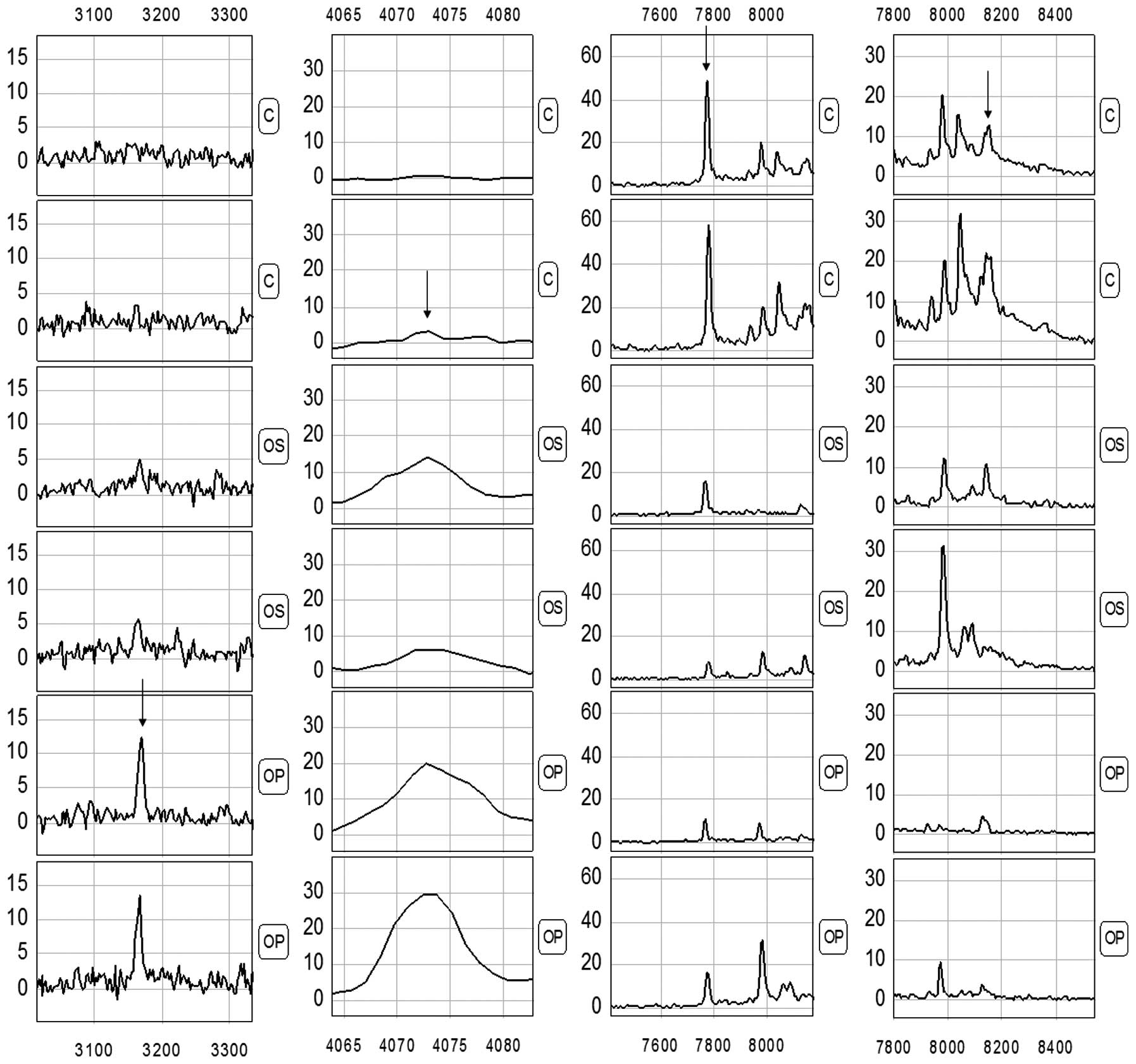Screening for specific biomarkers in the serum of postmenopausal osteoporosis patients using proteomic fingerprint techniques
- Authors:
- Weixing Li
- Chibo Liu
- Haibao Wang
-
View Affiliations
Affiliations: Center of Laboratory Medicine, Zhejiang Provincial People's Hospital, Hangzhou, Zhejiang 310014, P.R. China, Department of Clinical Laboratory, Taizhou Municipal Hospital, Taizhou, Zhejiang 318000, P.R. China, Department of Orthopedics, Taizhou Municipal Hospital, Taizhou, Zhejiang 318000, P.R. China
- Published online on: September 25, 2012 https://doi.org/10.3892/br.2012.12
-
Pages:
129-133
Metrics:
Total
Views: 0 (Spandidos Publications: | PMC Statistics:
)
Metrics:
Total PDF Downloads: 0 (Spandidos Publications: | PMC Statistics:
)
This article is mentioned in:
Abstract
The aim of this study was to detect serum protein biomarkers and establish a diagnostic model for postmenopausal osteoporosis (PMOP) adopting matrix-assisted laser desorption/ionization time-of-flight mass spectrometry (MALDI-TOF MS) combined with weak cationic exchange (WCX) magnetic beads, and to study the clinical significance of the model in the early diagnosis of PMOP. Serum samples from 45 patients with PMOP, 30 patients with osteopenia and 40 healthy controls were prepared using WCX magnetic beads, and were then analyzed using a PBSⅡ-C mass spectrometer reader. The protein spectra of the serum samples were normalized using the Ciphergen Proteinchip software. The peak labeling was performed using the Biomarker Wizard software. The specific protein biomarkers were screened using the Biomarker Pattern software to construct a diagnostic model for PMOP. A total of 138 discriminative mass-to-charge (m/z) ratios were found to be associated with PMOP. Of these, the m/z peaks at 3167.4, 4071.1, 7771.7 and 8140.5 were used to construct a diagnostic model in a training set. In a test set, the sensitivity and specificity of the model were 91.11 and 92.86%, respectively. Potential protein biomarkers for PMOP were detected in patient serum using MALDI-TOF MS combined with WCX magnetic beads. This model of multiple biomarkers provided a powerful and reliable diagnostic method for PMOP diagnosis with high sensitivity and specificity.
View References
|
1.
|
Mazzuoli G, Acca M, Pisani D, et al:
Annual skeletal balance and metabolic bone marker changes in
healthy early postmenopausal women. Bone. 26:381–386. 2000.
View Article : Google Scholar : PubMed/NCBI
|
|
2.
|
Wark JD: Osteoporotic fractures:
background and prevention strategies. Maturitas. 23:193–207. 1996.
View Article : Google Scholar : PubMed/NCBI
|
|
3.
|
Li YZ, Hu CJ, Leng XM, et al: Promising
diagnostic biomarkers for primary biliary cirrhosis identified with
magnetic beads and MALDI-TOF-MS. Anat Rec (Hoboken). 292:455–460.
2009. View
Article : Google Scholar : PubMed/NCBI
|
|
4.
|
Liu C, Shen J, Pan C, et al: MALDI-TOF MS
combined with magnetic beads for detecting serum protein biomarkers
and establishment of boosting decision tree model for diagnosis of
hepatocellular carcinoma. Am J Clin Pathol. 134:235–241. 2000.
View Article : Google Scholar
|
|
5.
|
European Foundation for Osteoporosis and
Bone Disease, National Osteoporosis Foundation: Who are candidates
for prevention and treatment for osteoporosis? Osteoporos Int.
7:1–6. 1997. View Article : Google Scholar
|
|
6.
|
Melton LJ III, Chrischilles EA, Cooper C,
et al: Perspective. How many women have osteoporosis? J Bone Miner
Res. 7:1005–1010. 1992. View Article : Google Scholar : PubMed/NCBI
|
|
7.
|
Nelson HD, Helfand M, Woolf SH and Allan
JD: Screening for postmenopausal osteoporosis: A review of the
evidence for the U.S. Preventive Services task force. Ann Intern
Med. 137:529–541. 2002. View Article : Google Scholar : PubMed/NCBI
|
|
8.
|
Lappe J, Kunz I, Bendik I, et al: Effect
of a combination of genistein, polyunsaturated fatty acids and
vitamins D3 and K1 on bone mineral density in postmenopausal women:
a randomized, placebo-controlled, double-blind pilot study. Eur J
Nutr. Feb 3–2012.(Epub ahead of print). View Article : Google Scholar
|
|
9.
|
Papierska L, Rabijewski M,
Kasperlik-Załuska A and Zgliczyński W: Effect of DHEA
supplementation on serum IGF-1, osteocalcin, and bone mineral
density in postmenopausal, glucocorticoid-treated women. Adv Med
Sci. 57:51–57. 2012. View Article : Google Scholar : PubMed/NCBI
|
|
10.
|
Voelker R: Osteoporosis screening may be
needed less often than previously believed. JAMA. 307:6542012.
View Article : Google Scholar : PubMed/NCBI
|
|
11.
|
Wang QT, Li YZ, Liang YF, et al:
Construction of a multiple myeloma diagnostic model by magnetic
bead-based MALDI-TOF mass spectrometry of serum and pattern
recognition software. Anat Rec (Hoboken). 292:604–610. 2009.
View Article : Google Scholar : PubMed/NCBI
|
|
12.
|
Liu CB, Liang Y, Pan CQ, et al: Proteome
study of differential protein expression in HBV-related primary
hepatic carcinoma. Chem J Chin Univ. 30:1763–1766. 2009.
|












